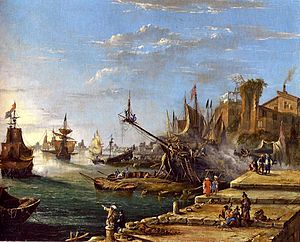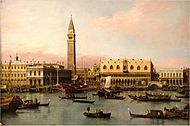What Was the Purpose of the Figurative Art Movement

Ein Meerhafen ("A Seaport"), a figurative landscape by the Austrian artist Johann Anton Eismann (1604–1698), which depicts buildings, people, ships, and other features that can be distinguished individually; by contrast, the abstract landscape below suggests its subject matter without directly representing it

Figurative art, sometimes written as figurativism, describes artwork (particularly paintings and sculptures) that is clearly derived from real object sources then is, by definition, representational. The term is often in dissimilarity to abstract art:
Since the arrival of abstract art the term figurative has been used to refer to whatsoever form of modern fine art that retains strong references to the real earth.[1]
Painting and sculpture can therefore be divided into the categories of figurative, representational and abstract, although, strictly speaking, abstract fine art is derived (or abstracted) from a figurative or other natural source. Nevertheless, "abstruse" is sometimes used as a synonym for non-representational art and not-objective art, i.eastward. art which has no derivation from figures or objects.
Figurative art is non synonymous with effigy painting (art that represents the human figure), although human and animate being figures are frequent subjects.
Formal elements [edit]
The formal elements, those aesthetic furnishings created by pattern, upon which figurative art is dependent, include line, shape, color, lite and night, mass, book, texture, and perspective,[2] although these elements of blueprint could likewise play a office in creating other types of imagery—for example abstruse, or non-representational or non-objective ii-dimensional artwork. The deviation is that in figurative fine art these elements are deployed to create an impression or illusion of class and space, and, usually, to create emphasis in the narrative portrayed.
| Sleeping Venus (a.1000.a. Dresden Venus) | |
|---|---|
 First known reclining nude in Western Fine art. Introduced the female nude as subject. | |
| Artist | Giorgione |
| Year | c. 1510 |
| Dimensions | 108.v×175 cm (42.7×69 in) |
Evolution [edit]

Figurative art is itself based upon a tacit understanding of abstracted shapes: the figure sculpture of Greek antiquity was not naturalistic, for its forms were idealized and geometric.[3] Ernst Gombrich referred to the strictures of this schematic imagery, the adherence to that which was already known, rather than that which is seen, equally the "Egyptian method", an allusion to the memory-based clarity of imagery in Egyptian art.[4] Eventually idealization gave way to observation, and a figurative art which counterbalanced ideal geometry with greater realism was seen in Classical sculpture by 480 B.C.[iii] The Greeks referred to the reliance on visual observation as mimesis. Until the time of the Impressionists, figurative art was characterized by attempts to reconcile these opposing principles.[four]
From the early Renaissance, Mannerism and the Bizarre through 18th-, 19th- and 20th-century painting Figurative art has steadily broadened its parameters. An important landmark in the evolution of figurative art is the start known reclining nude in Western painting in Sleeping Venus (1510) past Giorgione.[5] It introduced the female person nude equally subject and started a long line of famous paintings.
Nicolas Poussin (1594–1665), a French painter in the classical fashion whose work predominantly features clarity, logic, and guild, and favors line over color, served equally an alternative to the more narrative Baroque style of the 17th century. He was a major inspiration for such classically oriented artists as Jacques-Louis David, Jean-Auguste-Dominique Ingres and Paul Cézanne. The rise of the Neoclassical art of Jacques-Louis David ultimately engendered the realistic reactions of Gustave Courbet and Édouard Manet leading to the multi-faceted figurative art of the 20th century.
In November, 2018, scientists reported the discovery of the oldest known figurative art painting, over 40,000 (perchance equally old equally 52,000) years former, of an unknown animal, in the cave of Lubang Jeriji Saléh on the Indonesian island of Borneo.[six] [7]
Architecture, townscape [edit]
-
Canaletto (c. 1737) View of the Piazzetta and The Bassin of San Marco in Venice
History painting [edit]
Human forms [edit]
-

Ancient Roman adult female on a balustrade (nine–xiv CE), Getty Villa
-

-

Landscape, seascape [edit]
Still life [edit]
Cavern painting [edit]
Meet too [edit]
- Abstract art
- Illustration
- Narrative art
- Neofigurative Fine art
- Realism (arts)
- Stuckism
Notes and references [edit]
- ^ Tate. "Glossary:Figurative". Archived from the original on 3 Feb 2012. Retrieved 21 October 2012.
- ^ Adams, Laurie Schneider, The Methodologies of Fine art, pages 17-nineteen. Westview Printing, 1996,
- ^ a b Clark, Kenneth, The Nude: A Report in Platonic Form, pages 31-2. Princeton University Press, 1990.
- ^ a b The Gombrich Archive: Printing statement on The Story of Fine art Archived October 6, 2008, at the Wayback Car
- ^ Reclining Nude. Ferrara, Lidia Grand. (Di 1 ban ed.). London: Thames & Hudson. 2002. ISBN978-0500237977. OCLC 966186187.
{{cite book}}: CS1 maint: others (link) - ^ Zimmer, Carl (seven November 2018). "In Cave in Borneo Jungle, Scientists Notice Oldest Figurative Painting in the World - A cave drawing in Kalimantan is at least 40,000 years onetime, raising intriguing questions about creativity in ancient societies". The New York Times . Retrieved 8 November 2018.
- ^ Aubert, Yard.; et al. (7 November 2018). "Palaeolithic cavern art in Borneo". Nature. 564 (7735): 254–257. doi:10.1038/s41586-018-0679-ix. PMID 30405242. S2CID 53208538. Retrieved 8 November 2018.
Source: https://en.wikipedia.org/wiki/Figurative_art





0 Response to "What Was the Purpose of the Figurative Art Movement"
ارسال یک نظر